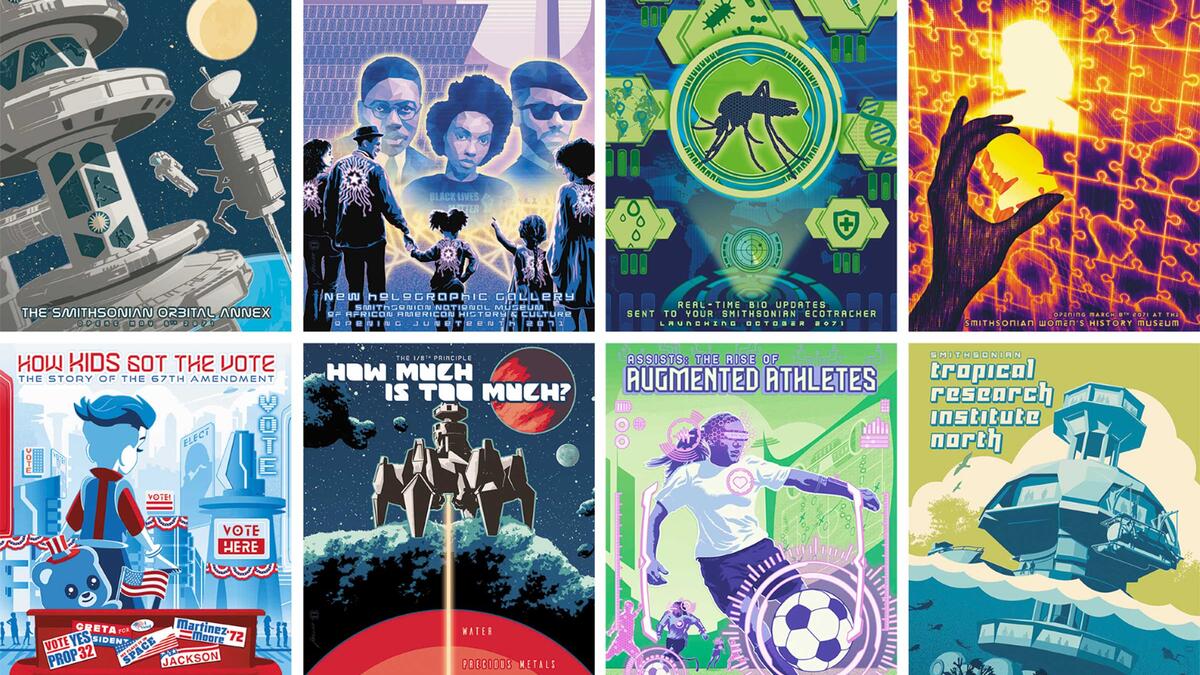ASU partners with Smithsonian Arts and Industries Building to explore multiple ‘FUTURES’

"Future Visions 2071," eight posters by artist Brian Miller, inspired by Smithsonian research.
We usually think of museums as repositories for the past, from Edison’s lightbulb and Bell’s telephone to the first Apollo rockets — but what happens when a museum explores the future? This is the question animating “FUTURES,” a brand-new exhibition at the Smithsonian’s Arts and Industries Building, debuting this fall in honor of the 175th anniversary of America’s museum.
As part of this nine-month, building-wide exploration of the future, curators from Smithsonian invited Arizona State University’s Center for Science and the Imagination to collaborate with Smithsonian research teams and envision possible future timelines informed by the inquiries, investigations and field research happening today at Smithsonian museums and laboratories all around the world. This portion of the overall exhibit is called “Future Visions 2071.”
“Museums are used to looking back into history,” said curator Glenn Adamson, “but gazing into the future is a lot more unusual. In this project, we were able to pair historians and scientists with specialists in imagining tomorrow — it was the perfect way to mark the 175th anniversary of the Smithsonian, which has always been an engine of the future.”
Throughout the winter and spring of 2021, the Center for Science and the Imagination convened eight teams of scholars and experts from Smithsonian museums and research centers, including the National Air and Space Museum, the Smithsonian Conservation Biology Institute, and the National Museum of African American History and Culture, to explore potential futures for their institutions, their areas of research and the communities they serve.
These discussions were bolstered by queries, prompts and speculative leaps from award-winning artist Brian Miller, and acclaimed science fiction writers Tochi Onyebuchi and Madeline Ashby, who brought these “future visions” to life through forward-looking exhibition posters and flash fiction stories — full narratives, all fewer than 2,000 words — set in the year 2071.
“Futures are not determined by just one decision-maker. Instead they’re built on countless cycles of deliberation, adaptation and inspiration drawn from multiple sources,” said Ruth Wylie, assistant director at the Center for Science and the Imagination. “The workshops distilled this process, activating a collaborative imagination between scientists, museum staff and the artists to envision the next 50 years of innovation and discovery.”
“Future Visions 2071” represents the wide array of contemporary, compelling scholarship happening at the Smithsonian’s various units — work that grapples with some of the most challenging topics on our shared horizon, including the ethics of asteroid mining and other off-world extraction, voting rights amid shifting identities and social arrangements, and how current studies on tropical ecosystems may inform how we live on an increasingly warming planet.
Following in the Smithsonian’s rich tradition of curation and interpretation, this new collection of stories and art brings human-centered narratives to the technical research and groundbreaking discoveries shaping our world, providing patrons firsthand experience with possible futures and their many complexities, rather than a staid recitation of the facts and theories that underpin them. All eight posters and their corresponding stories will be on display at the Arts and Industries Building when “FUTURES” debuts on Nov. 20.
This project marks another successful collaboration in future visioning from the Center for Science and the Imagination, which has previously been called on by NASA, Google, the World Bank and others to use the methods of speculative fiction, scenario planning and worldbuilding as a way to engage the public in critical conversations about science, technology, society and the future.
For Ashby, a strategic foresight consultant and longtime Center for Science and the Imagination collaborator, the stakes were even higher.
“Writing for this exhibition challenged me to be fearlessly hopeful, in a way that I’m usually not,” she said. “But when I put myself in the shoes of the museum’s visitors, I realized I was telling stories for the whole of America — including people who are very different from me, who have different views and experiences from mine and who might not be familiar with my genre. I thought about a grandparent reading a story to their grandchild. I thought about the conversations that might arise from there. When I thought of it that way, I was able to focus more intently on the hopes multiple generations might share.”
Onyebuchi echoed that optimistic reaction.
“Working with and listening to these researchers and curators, these custodians not just of history but also of curiosity itself, vastly expanded my ideas of the possible,” he said. “There is crisis at work but also hope. That is what I felt whenever I left these conversations to work on these stories: hope.”
Stories and art from “Future Visions 2071” are available now on Future Tense, a partnership with Slate, New America and ASU. To celebrate the launch, Future Tense will host a free online panel conversation between Miller, Ashby and Onyebuchi, moderated by Adamson and Wylie, at noon EST, Tuesday, Nov. 9.
The overall exhibit “FUTURES” will be open to the public from Nov. 20–July 6 at the Smithsonian’s Arts and Industries building in Washington, D.C. For more information, the public can visit aib.si.edu.
More Science and technology

ASU-led space telescope is ready to fly
The Star Planet Activity Research CubeSat, or SPARCS, a small space telescope that will monitor the flares and sunspot activity…

ASU at the heart of the state's revitalized microelectronics industry
A stronger local economy, more reliable technology, and a future where our computers and devices do the impossible: that’s the…

Breakthrough copper alloy achieves unprecedented high-temperature performance
A team of researchers from Arizona State University, the U.S. Army Research Laboratory, Lehigh University and Louisiana State…

